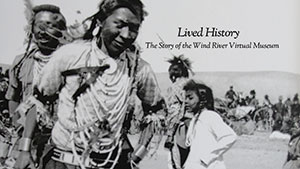Colorful regalia, artisans, Native American drummers and dancers and a major social gathering are all part of the Central Wyoming College United Tribes Club annual Spring Powwow Saturday, May 4.
Also scheduled that day is a free public screening of a 30-minute Wyoming PBS film that chronicles the journey of Eastern Shoshone and Northern Arapaho youth and elders to The Field Museum in Chicago. Over the span of 100 or more years, pipes, cradle boards, parfleches and other ancestral artifacts from the Wind River Reservation wound up in museums across the country.
The screening of Lived History: The Story of the Wind River Virtual Museum takes place in room 116 of the Intertribal Center at 3:30 p.m.
Following the film, there will be a panel discussion with the filmmakers and tribal members, and the unveiling of the Wind River Virtual Museum kiosk, which displays images of the artifacts.
Some of the artifacts had been purchased over the century while others had been stolen. “Lived History” documents the creation of a video archive of these precious ancestral artifacts.
The Powwow’s Gourd Dancing begins at 1 p.m. on the lawn in front of CWC’s Intertribal Education and Community Center. If the weather does not cooperate, the dancing is moved into the CWC Gym, located in the Student Center.
The powwow continues after the Wyoming PBS event with a 6 p.m. grand entry in the gym. At last year’s powwow, there were 11 drum groups and 140 dancers of all ages, said Sergio Maldonado, the advisor for the United Tribes Club.
“It was beautiful,” Maldonado said of the 2012 powwow in which about 1,500 people came to watch. At this year’s activity, visual and performing artists are showcased, and community elders will be honored. There will also be a number of vendors in the Student Center lobby.
Maldonado is expecting the Wind River Reservation group that won at last year’s Gathering of Nations powwow in Albuquerque, N.M. to perform. Also on tap are jingle and traditional dance, women’s and men’s fancy dancing and men’s grass dancers.
Also participating are well-known drum groups. He said the songs are much like chants though the harmony or melodies have a “specific linguistic interpretation. Many of the songs are known as vocables,” he explained. “They are melodic phrases and are sung in that way.”
To see the outfits the dancers wear is worth the price of the free admission. “There are common threads that all dance styles have, but every dancer personalizes their regalia,” Maldonado said. Each dancer adds pieces from family members which may have been handed down through the generations. “Every person’s dance outfit is both social and sacred.” He said. “It’s a part of their identity.”
SPRING POWWOW INCLUDES WYO PBS DOCUMENTARY



